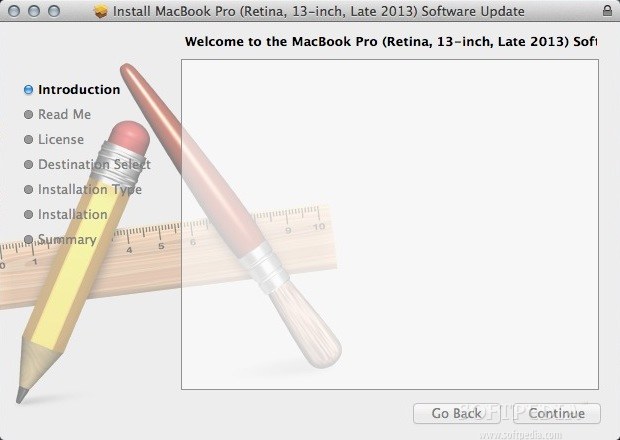Macbook Pro 13 Software Update
Macbook Pro 13 Software Update
Select the Apple Menu, then App Store. Select the App Store menu, then Preferences. Make sure Automatic Updates is checked. MacBook, MacBook Pro, and MacBook Air must have the power adapter plugged in to automatically download updates. Software Update doesn’t have any new software for your computer at this time.' I tried a manual update by executing a command line in terminal: sudo sh -c “softwareupdate -ia && reboot. This should update it, but it only reboots the computer. The MacBook Pro (Retina, 13-inch, Late 2013) Software Update has been released by Apple to address issues with the Chinese (both Simplified and Traditional versions) of the Software License Agreement. MacBook Pro (Retina, 13-inch, Late 2013) Software Update fixes the problem. Download Apple MacBook Pro Software Update for Mac to patch your MacBook Pro early 2011 model. About MacBook Pro Software Update 1.4. This update includes fixes that improve graphics stability, address issues with external display support and 3D performance, and improve Thunderbolt device support. Boot ROM or SMC Version Information: After update OS build version = 10J4035.
- Macbook Pro 13 Inch Update
- Macbook Pro System Update
- Apple Macbook Pro Software Update
- Macbook Pro 13 Software Update Windows 10
How to get updates for macOS Mojave or later
If you've upgraded to macOS Mojave or later, follow these steps to keep it up to date:
- Choose System Preferences from the Apple menu , then click Software Update to check for updates.
- If any updates are available, click the Update Now button to install them. Or click ”More info” to see details about each update and select specific updates to install.
- When Software Update says that your Mac is up to date, the installed version of macOS and all of its apps are also up to date. That includes Safari, iTunes, Books, Messages, Mail, Calendar, Photos, and FaceTime.
To find updates for iMovie, Garageband, Pages, Numbers, Keynote, and other apps that were downloaded separately from the App Store, open the App Store on your Mac, then click the Updates tab.
To automatically install macOS updates in the future, including apps that were downloaded separately from the App Store, select ”Automatically keep my Mac up to date.” Your Mac will notify you when updates require it to restart, so you can always choose to install those later.
How to get updates for earlier macOS versions
If you're using an earlier macOS, such as macOS High Sierra, Sierra, El Capitan, or earlier,* follow these steps to keep it up to date:
- Open the App Store app on your Mac.
- Click Updates in the App Store toolbar.
- Use the Update buttons to download and install any updates listed.
- When the App Store shows no more updates, the installed version of macOS and all of its apps are up to date. That includes Safari, iTunes, iBooks, Messages, Mail, Calendar, Photos, and FaceTime. Later versions may be available by upgrading your macOS.
To automatically download updates in the future, choose Apple menu > System Preferences, click App Store, then select ”Download newly available updates in the background.” Your Mac will notify you when updates are ready to install.
* If you're using OS X Lion or Snow Leopard, get OS X updates by choosing Apple menu > Software Update.
How to get updates for iOS

Macbook Pro 13 Inch Update
Learn how to update your iPhone, iPad, or iPod touch to the latest version of iOS.
Macbook Pro System Update

Apple Macbook Pro Software Update
Learn more
Macbook Pro 13 Software Update Windows 10
- Learn how to upgrade to the latest version of macOS.
- Find out which macOS your Mac is using.
- You can redownload apps that you previously downloaded from the App Store.
- Your Mac doesn't automatically download large updates when it's using a Personal Hotspot.
Macbook Pro 13 Software Update
